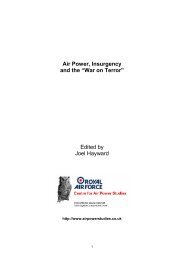Air Power, Insurgency and the âWar on Terrorâ - Prof. Joel Hayward's ...
Air Power, Insurgency and the âWar on Terrorâ - Prof. Joel Hayward's ...
Air Power, Insurgency and the âWar on Terrorâ - Prof. Joel Hayward's ...
Create successful ePaper yourself
Turn your PDF publications into a flip-book with our unique Google optimized e-Paper software.
The RAF in Counter-<str<strong>on</strong>g>Insurgency</str<strong>on</strong>g> Warfare: British Interventi<strong>on</strong> in Greece, 1944-45<br />
Naked bodies were found dumped <strong>on</strong> <str<strong>on</strong>g>the</str<strong>on</strong>g> side of <str<strong>on</strong>g>the</str<strong>on</strong>g> road <str<strong>on</strong>g>and</str<strong>on</strong>g> most had been ritually<br />
mutilated (<str<strong>on</strong>g>the</str<strong>on</strong>g> cutting out of hearts was a comm<strong>on</strong> political statement). Faced with this<br />
situati<strong>on</strong>, General Scobie had no alternative but to order British troops into acti<strong>on</strong>. The<br />
stated objective was to drive all insurgents out of A<str<strong>on</strong>g>the</str<strong>on</strong>g>ns <str<strong>on</strong>g>and</str<strong>on</strong>g> to restore law <str<strong>on</strong>g>and</str<strong>on</strong>g> order. 211<br />
Five December saw <str<strong>on</strong>g>the</str<strong>on</strong>g> first role for <str<strong>on</strong>g>the</str<strong>on</strong>g> RAF squadr<strong>on</strong>s: rec<strong>on</strong>naissance <str<strong>on</strong>g>and</str<strong>on</strong>g> air<br />
interdicti<strong>on</strong> of ELAS lines of communicati<strong>on</strong> in <str<strong>on</strong>g>and</str<strong>on</strong>g> out of A<str<strong>on</strong>g>the</str<strong>on</strong>g>ns. Although ELAS had<br />
c<strong>on</strong>trol of most of <str<strong>on</strong>g>the</str<strong>on</strong>g> countryside by this point, <str<strong>on</strong>g>the</str<strong>on</strong>g>y were extremely vulnerable to air<br />
attack, <str<strong>on</strong>g>and</str<strong>on</strong>g> were, <str<strong>on</strong>g>the</str<strong>on</strong>g>refore, compelled to do most of <str<strong>on</strong>g>the</str<strong>on</strong>g>ir moves under cover of darkness.<br />
They were also very short of motorised transport, so <strong>on</strong>ly <str<strong>on</strong>g>the</str<strong>on</strong>g>ir most important logistics<br />
travelled by this means, while general stores <str<strong>on</strong>g>and</str<strong>on</strong>g> food were transported by horse or mule<br />
<str<strong>on</strong>g>and</str<strong>on</strong>g> sometimes by ELAS fighters <str<strong>on</strong>g>the</str<strong>on</strong>g>mselves. There was a c<strong>on</strong>scious effort by <str<strong>on</strong>g>the</str<strong>on</strong>g> RAF to<br />
interdict ELAS Lines of Communicati<strong>on</strong> out to a distance of 70 miles in order to isolate<br />
<str<strong>on</strong>g>the</str<strong>on</strong>g> battlefield <str<strong>on</strong>g>and</str<strong>on</strong>g> make <str<strong>on</strong>g>the</str<strong>on</strong>g> insurgency “wi<str<strong>on</strong>g>the</str<strong>on</strong>g>r <strong>on</strong> <str<strong>on</strong>g>the</str<strong>on</strong>g> vine”. This was feasible because<br />
<str<strong>on</strong>g>the</str<strong>on</strong>g> Royal Navy had a number of vessels exercising sea c<strong>on</strong>trol, including HMS Ajax, <str<strong>on</strong>g>and</str<strong>on</strong>g><br />
<str<strong>on</strong>g>the</str<strong>on</strong>g> RAF was also performing anti-shipping operati<strong>on</strong>s in <str<strong>on</strong>g>the</str<strong>on</strong>g> eastern Mediterranean. As a<br />
c<strong>on</strong>sequence, ELAS vessels had difficulty circumventing this blockade. L<strong>on</strong>g-range aerial<br />
rec<strong>on</strong>naissance occurred at least <strong>on</strong>ce a day from 5 December, with a particular focus <strong>on</strong><br />
<str<strong>on</strong>g>the</str<strong>on</strong>g> approaches to A<str<strong>on</strong>g>the</str<strong>on</strong>g>ns from <str<strong>on</strong>g>the</str<strong>on</strong>g> north <str<strong>on</strong>g>and</str<strong>on</strong>g> also from <str<strong>on</strong>g>the</str<strong>on</strong>g> Pelop<strong>on</strong>nese, <str<strong>on</strong>g>and</str<strong>on</strong>g> a picture<br />
of ELAS supply routes <str<strong>on</strong>g>and</str<strong>on</strong>g> supply dumps became apparent. This was comparatively easy<br />
in relati<strong>on</strong> to ELAS motorised <str<strong>on</strong>g>and</str<strong>on</strong>g> horse-drawn transport because <str<strong>on</strong>g>the</str<strong>on</strong>g> road infrastructure<br />
was limited to a h<str<strong>on</strong>g>and</str<strong>on</strong>g>ful of main arterial roads feeding into A<str<strong>on</strong>g>the</str<strong>on</strong>g>ns. The same can be<br />
said of <str<strong>on</strong>g>the</str<strong>on</strong>g> Greek rail network, which was limited to <strong>on</strong>e principal north-south rail line.<br />
Because most rolling stock had been plundered by <str<strong>on</strong>g>the</str<strong>on</strong>g> German occupying forces, very<br />
little remained intact by 1944 <str<strong>on</strong>g>and</str<strong>on</strong>g> movement by rail was comparatively rare. 212<br />
By 6 December, not <strong>on</strong>ly had <str<strong>on</strong>g>the</str<strong>on</strong>g> Communists secured <str<strong>on</strong>g>the</str<strong>on</strong>g> countryside around A<str<strong>on</strong>g>the</str<strong>on</strong>g>ns,<br />
but British forces found <str<strong>on</strong>g>the</str<strong>on</strong>g>mselves surrounded by what were described as “very thorough<br />
<str<strong>on</strong>g>and</str<strong>on</strong>g> determined” ELAS forces in <str<strong>on</strong>g>the</str<strong>on</strong>g> centre of A<str<strong>on</strong>g>the</str<strong>on</strong>g>ns, inside, in effect, a “Green Z<strong>on</strong>e”<br />
which measured two miles by 1.5 miles. 213 The <strong>on</strong>ly means of re-supply was via tank <str<strong>on</strong>g>and</str<strong>on</strong>g><br />
armoured car c<strong>on</strong>voys back <str<strong>on</strong>g>and</str<strong>on</strong>g> forth to <str<strong>on</strong>g>the</str<strong>on</strong>g> Hassani airfield, five miles to <str<strong>on</strong>g>the</str<strong>on</strong>g> south-east<br />
(which subsequently became A<str<strong>on</strong>g>the</str<strong>on</strong>g>ns airport), down a single roadway. This roadway was<br />
subjected to mortar <str<strong>on</strong>g>and</str<strong>on</strong>g> artillery fire, improvised explosive devices (IEDs), <str<strong>on</strong>g>and</str<strong>on</strong>g> captured<br />
German mines were laid under <str<strong>on</strong>g>the</str<strong>on</strong>g> cover of darkness. By 11 December, <str<strong>on</strong>g>the</str<strong>on</strong>g> besieged<br />
British <str<strong>on</strong>g>and</str<strong>on</strong>g> friendly forces had less than three days’ supply of ammuniti<strong>on</strong> left. It was<br />
increasingly obvious that an alternative had to be found. The RAF was called up<strong>on</strong> to<br />
perform a massive re-supply <str<strong>on</strong>g>and</str<strong>on</strong>g> airdrop, beginning <strong>on</strong> 12 December, enabling troops<br />
to secure ground around A<str<strong>on</strong>g>the</str<strong>on</strong>g>ns, especially crucial lines of communicati<strong>on</strong> to <str<strong>on</strong>g>the</str<strong>on</strong>g> sea,<br />
at Phaler<strong>on</strong> Bay. At this stage, ELAS forces were in complete c<strong>on</strong>trol of <str<strong>on</strong>g>the</str<strong>on</strong>g> main port<br />
102<br />
<str<strong>on</strong>g>Air</str<strong>on</strong>g> <str<strong>on</strong>g>Power</str<strong>on</strong>g>, <str<strong>on</strong>g>Insurgency</str<strong>on</strong>g> <str<strong>on</strong>g>and</str<strong>on</strong>g> <str<strong>on</strong>g>the</str<strong>on</strong>g> “War <strong>on</strong> Terror”





